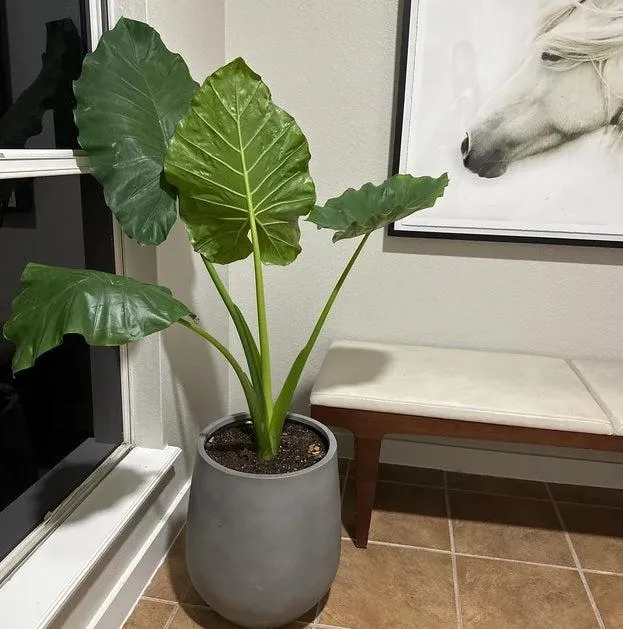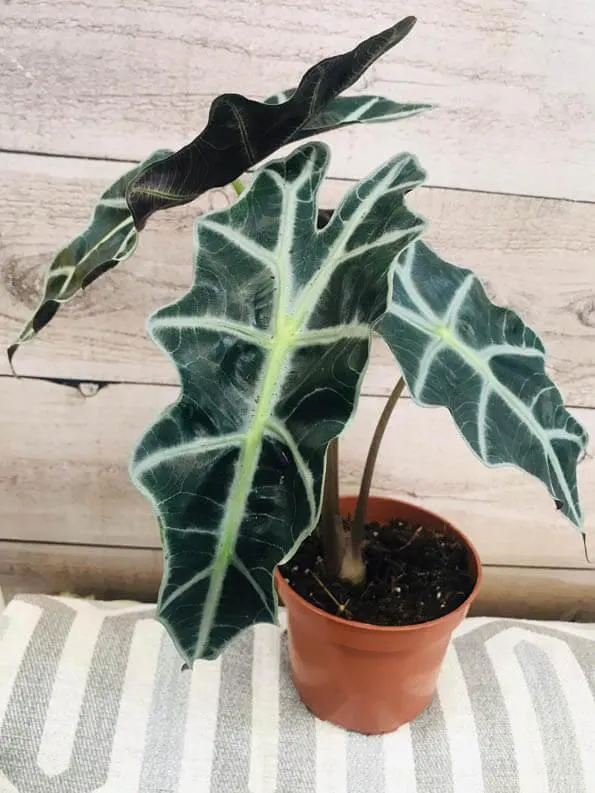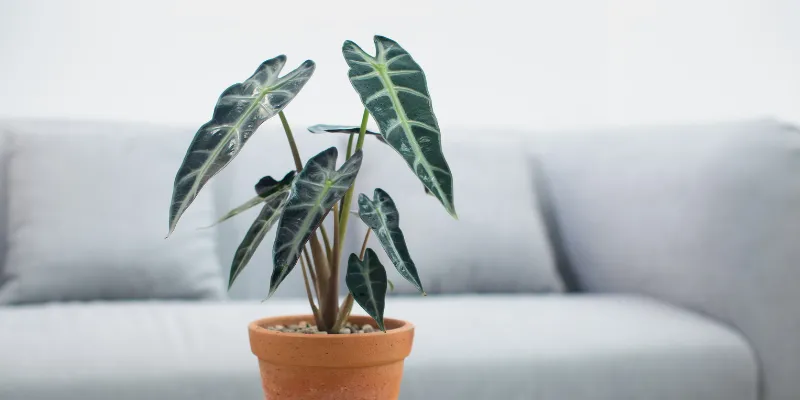Are Alocasias Cat-Safe Houseplants?
If you have curious cats exploring your home and digging in your plant collection, you may wonder whether certain houseplants are safe for feline friends. One plant type often questioned is alocasias, with their beautiful arrow-shaped leaves. In this article, I’ll explore the ins and outs of alocasias and cats to help you determine if these plants are a good fit for your plant-loving pets.
Alocasia Toxicity Level
To start, it’s important to understand the toxic risk level that alocasias present. The ASPCA Animal Poison Control Center classifies all alocasia varieties as “moderately toxic” to cats if ingested. This means that eating parts of the plant could potentially cause vomiting, diarrhea, or other mild gastrointestinal upset in cats. However, severe effects are generally not expected unless a very large amount is consumed.
The particular toxic compounds in alocasias that can cause issues for cats are calcium oxalate raphide crystals. These tiny needle-like crystals are present throughout the plant and can irritate the mouth and gastrointestinal tract if eaten. Fortunately, cats would need to ingest a significant quantity of the plant material to encounter dangerous levels of crystals.
Supervision Is Key
From my experience owning both plants and cats, supervision is the most important factor when weighing the risks of alocasias for felines. While moderate toxicity means the plants are unlikely to seriously endanger cats with just a taste, without oversight those tastes could add up as cats investigate with their curious paws and mouths.
The best way to safely allow alocasias in a cat home is to place the plants in areas your cats can’t access without your knowledge, such as on high shelves out of jumping range or behind barriers like shut doors. You’ll also want to monitor plant interactions and remove any chewed or torn leaves immediately to prevent further ingestion.

Other Safety Considerations
Aside from ingestion risks, alocasias present a couple other potential hazards for cats:
- Poisoning by contact: The calcium oxalate crystals can irritate skin and mucous membranes on contact. Cats may rub against foliage and subsequently lick their fur, risking oral exposure to plant crystals.
- Injuries from sharp leaves: The arrowhead foliage has stiff, pointed tips that could potentially scratch or cut a cats skin if they rub against it vigorously.
For these reasons, I always place my large alocasia varieties up high where curious paws can’t disturb the leaves. However, smaller cultivars grown as tabletop plants require extra diligence to keep them well away from furry friends who sometimes enjoy rearranging décor to their liking!
Non-Toxic Alternative Varieties?
Some pet owners wonder if certain less common alocasia varieties might present less risk. However, plant experts indicate that all members of the Alocasia genus can reasonably be expected to contain irritating calcium oxalate crystals throughout. So I wouldn’t rely on any one type being definitively “cat-safe.”
That said, smaller, slower growing cultivars like ‘Polly’ or ‘Portora’ may be slightly less enticing for cats to sample due to their dainty statures. These could possibly work with higher shelves and close monitoring. But there are always no guarantees with curious kitties!
Admiring from Afar
Ultimately, every cat is an individual – some may leave alocasias alone while others can’t resist a nibble! From my experience, it’s generally not worth the risk unless you can absolutely ensure plants remain untouched. If cats will have any access, even potentially, it’s kinder to all to simply admire beautiful alocasias from a distance where paws can’t reach.

Luckily, alocasias are not the only stunning tropicals suitable for growing with cats. Non-toxic alternativess like philodendrons, pothos, spider plants and peace lilies offer gorgeous leaf varieties without toxicity concerns. These lower-risk plants allow both you and your furry friends joy of houseplants without worries!
Creating Cat-Safe Spaces
For those wanting to keep certain cat-questionable plants, creating dedicated “cat-free” zones can help achieve plant and pet harmony. Enclose plant display areas behind baby gates, tall barriers or closed doors your felines can’t access will let you safely enjoy your entire collection. You can also use repellents on furniture to discourage napping or climbing near toxin-containing foliage.
With supervised time and cat-proofed growing areas, alocasias don’t need to be an outright “no” for homes with curious kitties. But their bitterness always warrants caution. By understanding each plant and pet, owners can make the best choice for their furry family members’ safety and happiness.
Consult Experts With Concerns
If you notice any questionable plant behavior from cats like nibbling, rubbing or licking, it is best to contact an animal poison control expert right away for guidance. They can assess risks specific to the amount potentially consumed and advise on watchfulness or potential treatment. It’s always better to check than to guess where plant poisons are involved.
With awareness, diligence and non-toxic alternatives on hand, hopefully this gives you a helpful overview into safely keeping – or not – alocasias in a multi-species home. But as always, cat health comes first. They may miss out on some pretty plants, but your furry friends will appreciate your care in keeping them safe and sound.

Is Alocasia Safe for Cats?
| Plant | Toxicity Level | Symptoms |
|---|---|---|
| Alocasia | Mildly Toxic | Mild mouth irritation, vomiting, drooling |
| Polka Dot Plant | Moderately Toxic | Mouth irritation, vomiting, diarrhea |
| Elephant Ear | Moderately Toxic | Mouth irritation, vomiting, depression |
| Chinese Evergeen | Highly Toxic | Vomiting, diarrhea, excessive drooling, depression |
| Dumb Cane | Highly Toxic | Mouth/tongue numbness, vomiting, difficulty swallowing |
FAQ
-
Can alocasia plants hurt cats?
Basically, alocasia plants aren’t poisonous to cats. But a cat’s curious nature could get itself into trouble around these plants. The stems, leaves, and roots contain insoluble needle-like calcium oxalate crystals. If a cat chews on the plant, these crystals could kind of irritate their mouth and cause some discomfort.
-
Are alocasia safe to have with cats?
For the most part, alocasia plants seem okay to keep around cats. As long as the cat isn’t munching on the leaves, stems or roots, it shouldn’t be a problem. At the same time, it’s probably better to be safe than sorry. Pick a spot high up where curious kitties can’t reach your alocasia. Or maybe keep it out of their play areas. Their sharp little claw could also damage the plant, so watch them closely.
-
Will an alocasia make my cat sick?
It’s unlikely an alocasia will make your cat really ill. However, those sharp calcium oxalate crystals the plant contains are no fun if eaten. Your cat may experience some mouth discomfort or an upset tummy. But except for that, alocasia aren’t generally considered toxic to cats. The plant’s crystals are poorly absorbed from the digestive tract in cats. So a single encounter probably won’t cause anything serious. But why take the risk when it’s easy to cat-proof your alocasia plant?
-
How do I keep my alocasia away from my cat?
There are a few different ways to keep curious cats from nibbling on your alocasia. You can place the plant high up out of paw’s reach, like on a tall shelving unit or hanging planter. Another option is to put it inside a cabinet or behind a closed baby gate. You could also try applying sticky substances like hot sauce or double-sided tape to the leaves and stems as a deterrent. Lastly, trimming your cat’s claws regularly helps prevent damage if they happen to bat or swat at the plant.
-
Can cats be around alocasia if not eating it?
For the most part, alocasia are probably okay for cats to be around as long as the plant isn’t being eaten. Their calcium oxalate crystals are poorly absorbed from the digestive tract. Maybe the occasional brush against the leaves poses little risk. Cats just occasionally shed or lick their fur too, so some indirect contact through their fur seems unlikely to cause problems. However, those needle-like crystals could possibly irritate skin or eyes if smushed against a cat. So like most houseplants, it’s still more cautious to keep alocasia where curious kitties can’t get a firm grip on the leaves.

-
What should I do if my cat eats an alocasia?
If despite your efforts, your cat manages to chew on an alocasia leaf, stem or root, there are a handful of things you should do. Firstly, remove any bits of the plant from your cat’s mouth. Then hose or wipe their mouth to remove any remaining crystals. You can also contact your vet and take your cat in for an exam. Stick to watching your cat closely for signs like drooling, vomiting or diarrhea in case the crystals cause any upset. In most cases, endoscopic removal of crystals from the esophagus is sufficient. But of course, it’s always best to prevent ingestion in the first place!
So in summary, alocasia themselves are maybe not truly toxic to cats. Their main risk comes from the irritation caused by those tiny calcium oxalate needle crystals if chewed or ingested. With a little diligence, you can basically keep these plants as decorative additions and your curious kitties safe at the same time.
